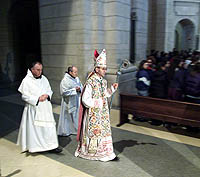
This very interesting website includes many relevant texts on the old and revised (1990) forms of the Hispanic Rite, also known as Gothic, Hispano-Mozarabic, or simply Mozarabic Rite, in Latin and in Spanish (it was exclusively in Latin in its pre-revision texts).
The new texts of the Mozarabic Missal were published by Cardinal González Martín, in 1990, "so that the faithful may participate, fully, actively and consciously in the liturgical celebrations (Cf. Sacrosanctum Concilium 14) [...] extensively to the other non-Roman rites, which, if necessary, are to be revised according to sound tradition to acquire new vigor." (Preface to the new Hispano-Mozarabic Missal). Well, that does not sound very promising.
The changes in the Gothic Canon (now called "Prex Eucharistica"...) were significant, but not extensive. Compare the pre-revision and post-revision consecration formulas below:
---------
--
The consecration formulas themselves have thankfully been preserved (and there is not a flood of different "Eucharistic Prayers", as it happened in the New Roman Mass), but several parts have been altered.
There are several changes in the Calendar (end of Septuagesima), in the Lectionary (years I and II), and so forth... Quite a splendid way to preserve their ancestors' heritage! The Mass may (must?) be wholly celebrated in the vernacular (poor people of old, who could not understand what the Mass was!), and may be ordinarily "concelebrated".
The website is quite interesting and full of up-to-date information (in Latin and Spanish), including some audio files, on the old and new forms of the Mozarabic Rite. More information on the unrevised Mozarabic Rite may be found in the Catholic Encyclopedia (and, offline, in extensive comments by Fr. Adrian Fortescue in several of his works and particularly in Dom Prosper Guéranger's Institutions Liturgiques).
Finally, is the new form celebrated versus Deum, as it had always been done? It has been difficult to find further information on this; the picture of this outdoor New Mozarabic Mass does not look promising (see here, last image). When will the liturgical revolution end?
The new texts of the Mozarabic Missal were published by Cardinal González Martín, in 1990, "so that the faithful may participate, fully, actively and consciously in the liturgical celebrations (Cf. Sacrosanctum Concilium 14) [...] extensively to the other non-Roman rites, which, if necessary, are to be revised according to sound tradition to acquire new vigor." (Preface to the new Hispano-Mozarabic Missal). Well, that does not sound very promising.
The changes in the Gothic Canon (now called "Prex Eucharistica"...) were significant, but not extensive. Compare the pre-revision and post-revision consecration formulas below:
Adesto adesto Jesu bone Pontifex in medio nostri: sicut fuisti in medio discipulorum tuorum: et sancti fica hanc oblationem ut sanctificata sumamus per manus sancti angeli tui sancte Domine et redemptor eterne.
Dominus noster Jesus Christus in qua (abstergit digitos) nocte tradebatur accepit panem (accipit Hostiam) et gratias agens (inclinet caput) benedixit ac fregit: deditque discipulis suis dicens. Accipite et manducate HOC EST CORPUS MEUM QUOD PRO VOBIS TRADETUR. Hic elevetur Corpus. Quotiescumque manducaveritis: hoc facite (alta voce omnibus diebus preter festivis) in meam commemorationem.
R\. Amen
Similiter et calicem postquam (eum accipit) cenavit dicens. Super calicem. HIC EST CALIX NOVI TESTAMENTI IN MEO SANGUINE QUI PRO VOBIS ET PRO MULTIS EFFUNDETUR IN REMISSIONEM PECCATORUM.
Hic elevetur calix coopertus cum filiola.
Quotiescumque biberitis: hoc facite (alta voce omnibus diebus preter festivis) in meam commemorationem.
R\. Amen
Quotiescumque manducaveritis panem hunc et calicem istum biberitis: mortem Domini annunciabitis: donec veniat; (alta voce omnibus diebus preter festivis) in claritatem de celis.
R\. Amen.
---------
Qui prídie quam paterétur,accépit panem (Sacerdos accipit patenam cum pane et elevans oculos prosequitur): et grátias agens,benedíxit ac fregit, dedítque discípulis suis, dicens: Accípite et manducáte:Hoc est Corpus meum quod pro vobis tradétur. Quotiescúmque manducavéritis, hoc fácite in meam commemoratiónem.
Omnes respondent:
Amen.
Sacerdos patenam in altare deponit. Accipiens calicem, sacerdos prosequitur: Simíliter et cálicem postquam cenávit dicens. Hic est calix novi testaménti in meo Sánguine qui pro vobis et pro multis effundétur in remissiónem peccatórum. Quotiescúmque bibéritis, hoc fácite in meam commemoratiónem.
Omnes respondent:
Amen.
Sacerdos calicem in altare deponit. Extensis manibus dicit:
Quotiescúmque manducavéritis panem hunc et cálicem istum bibéritis, mortem Dómini annuntiábitis donec véniat in claritáte de cælis.
Omnes acclamant:
Sic crédimus, Dómine Iesu.
--
The consecration formulas themselves have thankfully been preserved (and there is not a flood of different "Eucharistic Prayers", as it happened in the New Roman Mass), but several parts have been altered.

There are several changes in the Calendar (end of Septuagesima), in the Lectionary (years I and II), and so forth... Quite a splendid way to preserve their ancestors' heritage! The Mass may (must?) be wholly celebrated in the vernacular (poor people of old, who could not understand what the Mass was!), and may be ordinarily "concelebrated".
The website is quite interesting and full of up-to-date information (in Latin and Spanish), including some audio files, on the old and new forms of the Mozarabic Rite. More information on the unrevised Mozarabic Rite may be found in the Catholic Encyclopedia (and, offline, in extensive comments by Fr. Adrian Fortescue in several of his works and particularly in Dom Prosper Guéranger's Institutions Liturgiques).
Finally, is the new form celebrated versus Deum, as it had always been done? It has been difficult to find further information on this; the picture of this outdoor New Mozarabic Mass does not look promising (see here, last image). When will the liturgical revolution end?